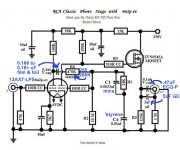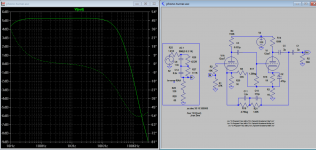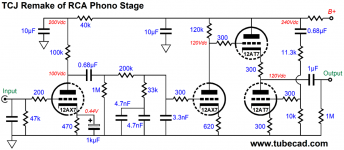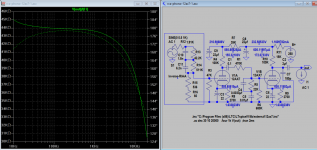I recently got a very nice pair of 6N2P (almost 12ax7) tubes. Which ended up in building a phono pre-amplifier using the schematic of turners website as shown below.
As the description on his page already mentions, the bass response is bad when driving loads below 200k ohms.
I think a good phono stage using only to 12ax7 or equivalent tubes should exist for MM cartridges. (I've seen a lot of boards and even ready to use preamps using only two double triode tubes)
The big question is, what are your experiences in using preamps with pairs of 12ax7. What kind of schematic/circuit would you recommend for a 100k load output?
Any thoughts are welcome!
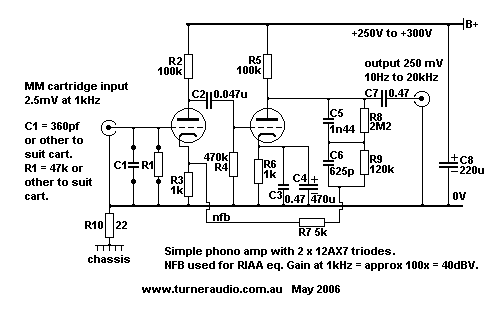
As the description on his page already mentions, the bass response is bad when driving loads below 200k ohms.
I think a good phono stage using only to 12ax7 or equivalent tubes should exist for MM cartridges. (I've seen a lot of boards and even ready to use preamps using only two double triode tubes)
The big question is, what are your experiences in using preamps with pairs of 12ax7. What kind of schematic/circuit would you recommend for a 100k load output?
Any thoughts are welcome!

the bass response is bad when driving loads below 200k ohms. What kind of schematic/circuit would you recommend for a 100k load output?
You'd need a direct coupled cathode follower output stage, which also drives the RIAA network.
Last edited:
DC coupled voltage follower yes, "hollow state" no. A ZVN0545A enhancement mode MOSFET is better at this particular job. Even the wimpy 'X7 triode drives that FET's tiny capacitances with aplomb.
The tweaked passive EQ schematic I've uploaded shows how to set a ZVN0545A source follower up.
The tweaked passive EQ schematic I've uploaded shows how to set a ZVN0545A source follower up.
Attachments
I recently got a very nice pair of 6N2P (almost 12ax7) tubes. Which ended up in building a phono pre-amplifier using the schematic of turners website as shown below.
As the description on his page already mentions, the bass response is bad when driving loads below 200k ohms.
I think a good phono stage using only to 12ax7 or equivalent tubes should exist for MM cartridges. (I've seen a lot of boards and even ready to use preamps using only two double triode tubes)
The big question is, what are your experiences in using preamps with pairs of 12ax7. What kind of schematic/circuit would you recommend for a 100k load output?
Any thoughts are welcome!
This Turner' phono is quite similar to Dynaco's. To drive 100K is not a big problem for 12AX7, but rather this RIAA eq uses NFB to operate, at low load the gain esp, at bottom end is insufficient hence the bass level. However Dynaco is better because it uses positive feedback to boost the gain as load is increased, hence the bottom end is better than Turner's which is a fixed gain good for fixed load. I have mod Dynaco, the sim shows has no problem to drive 50K load. If you use original RCA passive RIAA EQ, there is'nt a problem down to 50K or so.
Attachments
Last edited:
Haven't tried it, but just a thought from this blog post, all the way at the bottom.
PS-10 & More SRPP Designs
Essentially similar to what Eli posted but with a hollow state follower vs. sand.
PS-10 & More SRPP Designs
Essentially similar to what Eli posted but with a hollow state follower vs. sand.
Attachments
Haven't tried it, but just a thought from this blog post, all the way at the bottom.
PS-10 & More SRPP Designs
Essentially similar to what Eli posted but with a hollow state follower vs. sand.
Interesting, but the first 12AX7 stage is run with a 0.44V cathode bias. With the grid-cathode voltage so low, won't the tube be likely to draw grid current? That would put a tough, changeable load on the cartridge, would it not?
More than 10 years ago, I did a remake of an RCA style phono stage, using the original circuit DC-coupled into a 12AV7 (plain old) cathode follower. I have to say, it worked out very well. I recently had it home for a checkup. I was comparing it to a Schiit Mani phono preamp I have, and I liked the RCA-with-CF much better (both driven by a Denon DL110 in a Technics SL1200mk2).
Eli's version with the source follower would be technically better, and easier to implement since there would be no need for a lifted heater supply.
--
Thank you for your great responses and the suggested circuits. I ordered a new chassis. I'll let you know when I get started!
Well that's a good question. I am not that good at circuits and tubes yet, so I thought building a less complicated design would be a good idea. The 12AX7 is quite common to me. I know there are better tubes, but I'm not building for the final end now. Just getting more experience through building. Never aiming too high so I can enjoy the succes and the learning process. In the future I will probably use more suitable tubes.
Why do you want to use 12AX7s? For industrial production of phono amplifiers that can easily be built and sound ok they are great but you can do way better with different valves. Rp is horribly high fur these low current high mu tubes like the 12AX7.
Well that's a good question. I am not that good at circuits and tubes yet, so I thought building a less complicated design would be a good idea. The 12AX7 is quite common to me. I know there are better tubes, but I'm not building for the final end now. Just getting more experience through building. Never aiming too high so I can enjoy the succes and the learning process. In the future I will probably use more suitable tubes.
Interesting, but the first 12AX7 stage is run with a 0.44V cathode bias. With the grid-cathode voltage so low, won't the tube be likely to draw grid current?
The grid is only seeing around 14mV peak to peak at the grid from a MM cart, a .44v bias should not be an issue.
Hi,
The Tubecad circuit is quite nice but one wonders why you'd want a White CF dc coupled to the preceding stage just to drive some cable to a line stage.
If you don't need extra gain you could cap couple the WF and put a volume control behind the cap and the WCF for instance.
Further thoughts, that 1.000 microF cathode decoupling cap is going to have an impact on the sound. Biasing the first stage more negative would allow for a smaller cap but some of the RIAA components may have to be changed as well.
Personally I quite like to drive a passive RIAA with a CF and do away with that bypass cap altogether. Again, that would require altering the RIAA stage somewhat.
Then there are mu-followers as an idea as well, etc., etc.
Last idea is to use Russian 6N2Ps instead of the ECC83 as these russkies are very close to one of the best ECC83 equivalents ever, namely the ECC808.
This would open up the possibility of using halves of it per channel or whatever is convenient.
Much cheaper too.
Last but not least there's the PS. Mucho importante and all too often negelected.
Anyhow, hundreds of variations on a theme are quite possible really.
Cheers,
The Tubecad circuit is quite nice but one wonders why you'd want a White CF dc coupled to the preceding stage just to drive some cable to a line stage.
If you don't need extra gain you could cap couple the WF and put a volume control behind the cap and the WCF for instance.
Further thoughts, that 1.000 microF cathode decoupling cap is going to have an impact on the sound. Biasing the first stage more negative would allow for a smaller cap but some of the RIAA components may have to be changed as well.
Personally I quite like to drive a passive RIAA with a CF and do away with that bypass cap altogether. Again, that would require altering the RIAA stage somewhat.
Then there are mu-followers as an idea as well, etc., etc.
Last idea is to use Russian 6N2Ps instead of the ECC83 as these russkies are very close to one of the best ECC83 equivalents ever, namely the ECC808.
This would open up the possibility of using halves of it per channel or whatever is convenient.
Much cheaper too.
Last but not least there's the PS. Mucho importante and all too often negelected.
Anyhow, hundreds of variations on a theme are quite possible really.
Cheers,
I've been trying to decide between the updated Radiotron and Pete Millet's LR phono stage.
I don't know if that is any help but I'd say Millet LR. At least when we are looking at the same circuit. Pete's amplifier does away with all the horror of the run of the mill phono stage: giant resistor to linearize frequency response and the capacitors (both coupling and eq).
A plus for the 6N2p is the very low microphonics. Tha's important for a phono preamplifier
I use them but the problem is ever the very hi Zout. (@ 50-60Kohm)
Hummmm ...the Zload about 250K.Big problem.
Not only the Zout is hi.Before RIAA filter needs a large resistance...and this generate important noise level.The caps are also lower value and this is critic, because the Miller effect of the second triode grid is an important part of the total capacity..Be careful with T=75/50uS constant.
I think is better for all a low Rp tube like a D3a in triode mode.
Cheers
I use them but the problem is ever the very hi Zout. (@ 50-60Kohm)
Hummmm ...the Zload about 250K.Big problem.
Not only the Zout is hi.Before RIAA filter needs a large resistance...and this generate important noise level.The caps are also lower value and this is critic, because the Miller effect of the second triode grid is an important part of the total capacity..Be careful with T=75/50uS constant.
I think is better for all a low Rp tube like a D3a in triode mode.
Cheers
Last edited:
The grid is only seeing around 14mV peak to peak at the grid from a MM cart, a .44v bias should not be an issue.
Contact potential won't cause any grid current at idle?
--
The input resistance won't be as 'infinite' as it usually is, but it will still be more than high enough not to significantly affect the cartridge loading.Contact potential won't cause any grid current at idle?
Hummmm ...the Zload about 250K.Big problem.
Not only the Zout is hi.Before RIAA filter needs a large resistance...and this generate important noise level.The caps are also lower value and this is critic, because the Miller effect of the second triode grid is an important part of the total capacity..Be careful with T=75/50uS constant.
I think is better for all a low Rp tube like a D3a in triode mode.
Cheers
Apart from the noise level the large resistor before the RIAA network is quite the dynamics killer. A CCS might help to linearise the network. But of course this would work way better with e.g. the D3A you proposed.
What does that even mean?Apart from the noise level the large resistor before the RIAA network is quite the dynamics killer.
What does that even mean?
Precisely my thought.
I have built phono using 12ax7 and Da3 and other valves. If designed well then there in no issue with dynamics.
On thing though, there is some variation in Rp for individual 12ax7 triodes... so if you are trying to get the frequency response perfect, then a valve with lower Rp will make it easier.
The 12ax7/ecc83 is an excellent valve.
Well I have to admit that though I'm not uncommon to tube amplifiers a lot of being discussed is new to me. Most of being spoken has been compared by the circuit or the design.
One thing that I was curious about is the higher output resistance of 250k driving a lower impedance of about 100k. This is something that could be tested and measured. Alas I do not own such equiptment to perform such tests.
I have been qualified as both a mechanical engineer and piano technician, which means I judge most designs by ear finally.
At the moment of writing I am still waiting for the chassis and the parts to come.
One thing that I was curious about is the higher output resistance of 250k driving a lower impedance of about 100k. This is something that could be tested and measured. Alas I do not own such equiptment to perform such tests.
I have been qualified as both a mechanical engineer and piano technician, which means I judge most designs by ear finally.
At the moment of writing I am still waiting for the chassis and the parts to come.
M Schekkerman
....
One thing that I was curious about is the higher output resistance of 250k driving a lower impedance of about 100k. This is something that could be tested and measured. Alas I do not own such equiptment to perform such tests. ...
That is why Simulator comes in handy. In fact the best load for this RCA phono amp with 12AX7 output is about 47K, just make sure the coupling cap is large enough for bottom end response at this load. 220K being the minimal load specific for this phono amp due the output stage is also accounted for freq. response (e.g 180p capacitor). As output buffer is added, this small cap can be eliminated and loading effect is minimized and linearity readjusted.
....
One thing that I was curious about is the higher output resistance of 250k driving a lower impedance of about 100k. This is something that could be tested and measured. Alas I do not own such equiptment to perform such tests. ...
That is why Simulator comes in handy. In fact the best load for this RCA phono amp with 12AX7 output is about 47K, just make sure the coupling cap is large enough for bottom end response at this load. 220K being the minimal load specific for this phono amp due the output stage is also accounted for freq. response (e.g 180p capacitor). As output buffer is added, this small cap can be eliminated and loading effect is minimized and linearity readjusted.
Attachments
- Status
- This old topic is closed. If you want to reopen this topic, contact a moderator using the "Report Post" button.
- Home
- Amplifiers
- Tubes / Valves
- 12ax7 Phono Preamplifier
